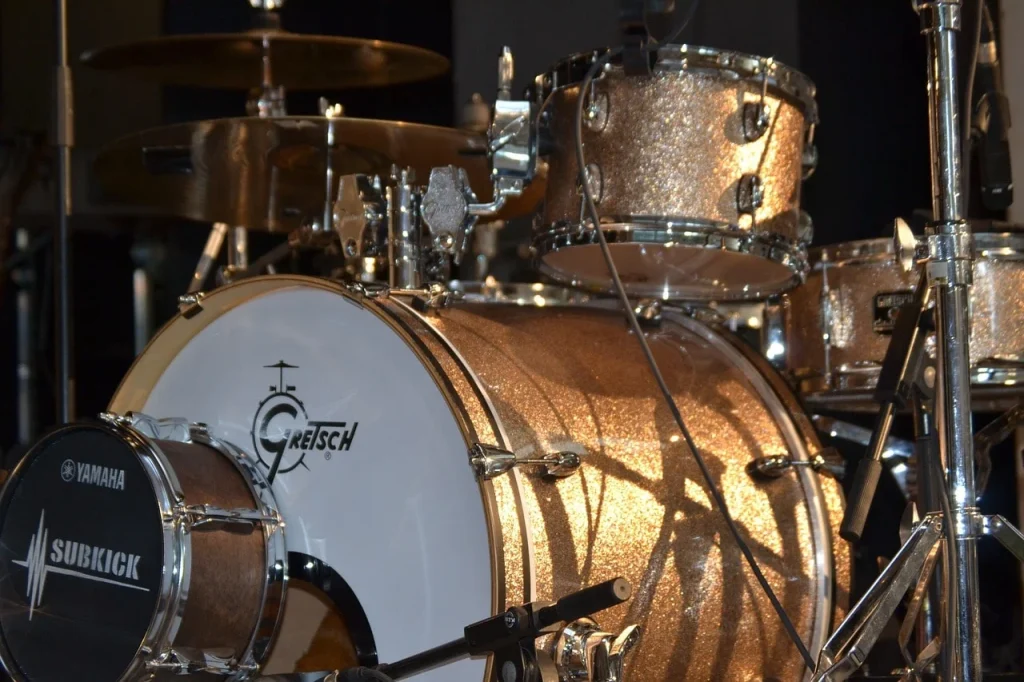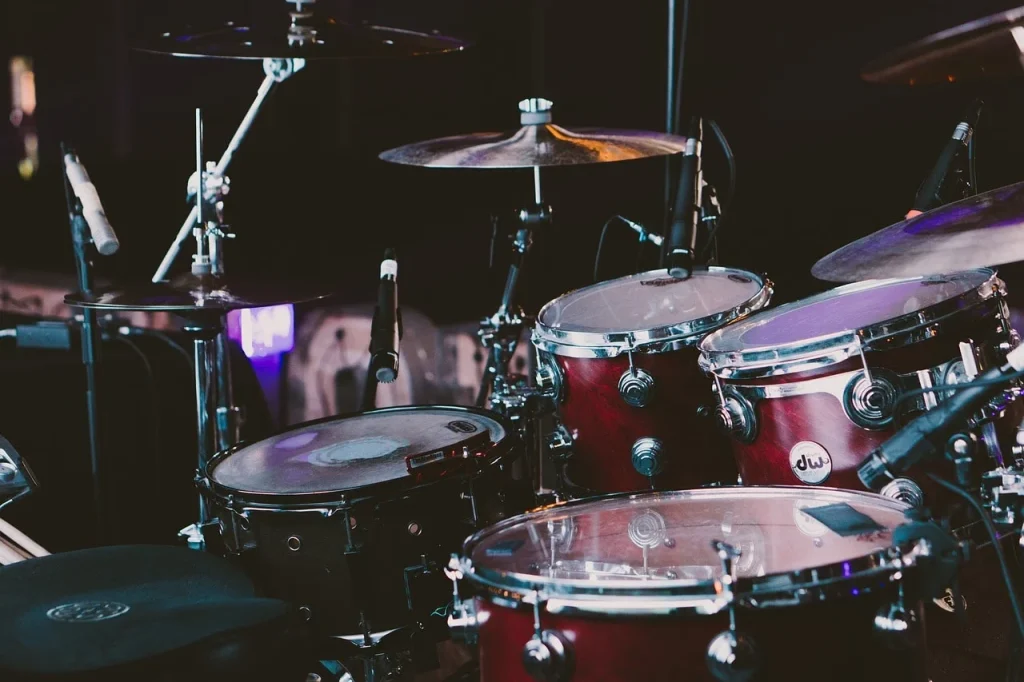Welcome to the world of drums, where every beat tells a story and the rhythm can move your soul (or at least your feet). They have been around for thousands of years, acting as the pulse of music from ancient tribal ceremonies to modern-day concerts.
They’re the unsung heroes of the music world, often overshadowed by flashy guitar solos and vocal gymnastics. But let’s be real: without drums, music would be like a sandwich without bread—still good, but missing something essential.
In this article, we’ll uncover some interesting facts about drums that will surprise, amuse, and maybe even inspire you to pick up a pair of drumsticks. But before we roll into the rhythm, have you ever wondered why drummers always look like they’re having the most fun in the band? Let’s find out.
The best way to predict the future is to invent it.
Neil Peart
Drums Facts
Let’s start our journey into the rhythmic world of drums with facts that span history, culture, and technique. Read carefully because I created a quiz for you at the end of this article to test your drum knowledge.
- The earliest known percussion instruments date back to 6,000 BC, found in the Neolithic cultures of China.
- Drumming can lead to a significant reduction in stress levels, according to several studies.
- Talking drums, which mimic the tone and prosody of language, have been used in Africa for thousands of years to communicate over long distances.
- The largest drum kit ever assembled had 813 pieces and was played by Dr. Mark Temperato in 2019.
- Djembe, a type of drum from West Africa, is thought to produce three distinct sounds, resembling the human voice.
- Playing drums can actually improve brain power and cognitive function, enhancing IQ scores in children.
- The speed of the world’s fastest drummer is 1,208 beats per minute, set by Tom Grosset in 2013.
- In military contexts, drums have been used for centuries to maintain the pace of marching or rowing.
- The biggest drum ever created measures 5.54 meters in diameter and was made in South Korea.
- Ghost notes are played so softly that they are felt more than heard, adding a layer of texture to the rhythm.
- Paradiddles, a basic drumming pattern, are considered fundamental for learning complex rhythms and improving dexterity.
- The first electronic drum was created by Graeme Edge in collaboration with Professor Brian Groves in the early 1970s.
- Beat deafness is a rare condition where individuals cannot feel or move to the beat of music.

- Berlin’s Love Parade in 1999 featured a drum that could be heard up to 15 miles away, promoting peace through music.
- The use of steel drums in music originated in Trinidad and Tobago, created from oil barrels left after World War II.
- Drum circles have been used as therapeutic sessions to build community and support mental health.
- The world’s oldest known drum was found in a Neolithic grave in Ukraine, dating back to 6,000 BC.
- Tablas, used in classical Indian music, are actually a pair of two different drums played together.
- A study found that drummers can outperform non-drummers in tests of both creativity and problem-solving.
- LED ZEPPELIN’s “When the Levee Breaks” is famed for its distinctive drum sound, recorded in a three-story stairwell.
- Animal skins, used on traditional drums, are often replaced by synthetic materials today for consistency and durability.
- Drum solos in rock and jazz can last for extended periods, showcasing the drummer’s skill, stamina, and creativity.
- The Guinness World Record for the largest drum ensemble, which featured 10,102 participants, was achieved in India in 2019.
- Rimshots produce a loud, sharp sound by striking the drumhead and the rim simultaneously and are used for dramatic effect.
- Cajóns, box-shaped percussion instruments, were originally used by slaves in Peru as substitutes for banned African drums.
- The term “breakbeat” originates from the break section in a song where all elements drop out except for the drums.
- Some cultures believe that drumming can facilitate a spiritual journey, connecting the physical and spiritual worlds.
- The Moeller Method is a drumming technique that combines economy of motion and relaxation for faster play.

- Drums made from hollowed-out logs and animal skins are still used in traditional ceremonies around the world.
- Stewart Copeland’s distinctive sound was partly due to his high-hat technique, often called “the magic hi-hat.”
- Drumming can act as a form of communication and has been historically used in rituals, ceremonies, and military exercises.
- Hybrid drumming setups combine acoustic and electronic elements, allowing for a wider range of sounds.
- The double bass drum setup was popularized by jazz and rock drummers seeking to enhance the power of their drumming.
- Renaissance military bands used drums to signal commands on the battlefield, influencing modern marching bands.
- Polyrhythms, or the use of two or more conflicting rhythms, are a staple in African drumming traditions and jazz.
- Drum tuning can drastically change the sound, with tight tuning for higher pitches and loose tuning for deeper tones.
- The snare drum’s distinctive sound comes from the snare wires stretched across its bottom head.
- Buddy Rich, considered one of the greatest drummers, was known for his virtuosic technique and speed.

- The balafon, an African instrument similar to a xylophone, is often accompanied by drums in traditional music.
- Drummers in rock bands are often positioned at the back of the stage, but they provide the backbone of the music.
- The first all-female drum and bugle corps, The Lassies, was formed in 1938, challenging gender norms in music.
- A drum’s shell material, such as wood, metal, or acrylic, significantly influences its tone and resonance.
- The Zildjian Company, founded in 1623, is one of the oldest manufacturers of cymbals in the world.
- Rototoms have no shell and are tuned by rotating the drumhead, offering a range of pitches not typical for traditional drums.
- Blast beats, a drumming technique using rapid alternation between the bass drum and snare, are a hallmark of extreme metal genres.
- The dhol, a double-sided barrel drum, is central to the music of the Punjab region in India and Pakistan.
- Drumming requires significant physical effort, with some drummers burning over 600 calories in an hour-long performance.
- Brushes are used on drums for a softer sound, originally developed for jazz drummers playing in quieter settings.
- The drumhead’s tension can be adjusted to change the pitch, with tighter tuning for higher sounds and looser for deeper ones.
- Muffling techniques, such as using moongel or drum rings, are used to control the overtones and sustain of a drum.
Drums Myths

Now that we’ve drummed up some facts, let’s march into the myths section. We’re ready to separate the truth from the tall tales, ensuring you get a clear idea of what’s real and what’s not.
- Drums Are Just for Keeping Rhythm
While it’s often believed that they only serve to keep the beat, they are much more versatile. In many musical pieces, they are used to enhance melody, create dynamic shifts, and add layers of emotional depth. Their contribution goes beyond rhythm, deeply enriching the musical experience. - Drumming Requires No Musical Knowledge
Contrary to the belief that drummers can get by without understanding music theory, knowledge of rhythms, scales, and time signatures is essential. For many musicians, the intricacies of musical theory are embraced, allowing them to contribute creatively to compositions and improvisations. - Electric Drums Can’t Match Acoustic Drums
While traditionalists may argue that electric drums lack the authenticity of acoustic sets, advancements in technology have significantly narrowed this gap. Many professionals use electric drums for their versatility, sound variety, and convenience without sacrificing quality. - Louder Playing Indicates Better Drumming
A common misconception is that louder drumming equates to better performance. However, in many musical contexts, the control of dynamics is valued over sheer volume. By skilled drummers, a wide dynamic range is often employed to convey emotions and complement the music. - Drummers Don’t Need to Read Music
Although it’s believed by some that drummers can get by without reading music, the ability to read sheet music is a valuable skill. With this skill, drummers are enabled to learn complex pieces more quickly, communicate effectively with other musicians, and participate in a broader range of musical projects.
No products found.
Drums Quotes

Renowned musicians often describe the drums as an extension of themselves. Prepare to be inspired by quotes that capture the intimate connection drummers forge with their instrument.
I don’t want to sound like Buddy Rich, but I think he was the greatest drummer that ever lived.
John Bonham
John Bonham, the powerhouse drummer for Led Zeppelin, expresses his admiration for Buddy Rich, highlighting Rich’s unparalleled skills on the drums.
The drums tell me everything. Everything else follows.
Charlie Watts
Charlie Watts, the iconic drummer for The Rolling Stones, emphasizes the foundational role of the drums in guiding the direction and dynamics of a song.
Playing fast around the drums is one thing. But to play music, to play with people for others to listen to, that’s something else. That’s a whole other world.
Tony Williams
Tony Williams, a prodigious jazz drummer, distinguishes between technical prowess and musicality, stressing the importance of serving the song and connecting with the audience.
It’s not the instrument that makes you sound good, it’s the player.
Sheila E.
Sheila E., a virtuoso drummer and percussionist known for her work with Prince and on her solo projects, asserts that talent and skill transcend the quality of the instrument.
Drumming is my middle name.
Ringo Starr
Ringo Starr, the beat-keeping heart of The Beatles, humorously asserts his natural affinity and deep connection with drumming as an integral part of his identity.
Drums FAQ

We continue to the next section. Pay close attention to this FAQ because it’s your final preparation before the quiz.
- Are drums hard to learn?
Learning to play the drums, like any musical instrument, has its challenges but can be incredibly rewarding. It requires coordination and rhythm, but with practice, anyone can get the hang of it. Starting with the basics and gradually increasing complexity is a great approach. - Why are drums important in music?
They are the backbone of most musical genres, providing the beat and rhythm that drive the music forward. They help to keep the tempo, add dynamics, and significantly influence the energy and mood of a piece. - Can drums be out of tune?
Yes, they can be out of tune. The tension of the drum skin affects the pitch, and if not properly tuned, it can affect the sound quality. Regular tuning is essential to maintain the desired sound. - What drums are in a drum set?
A standard drum set usually includes a bass drum, snare drum, one or more tom-toms, a hi-hat, and a crash and ride cymbal. Some drummers add additional elements, like more cymbals or tom-toms, for a wider range of sounds. - Are electronic drums a good alternative to acoustic drums?
Electronic drums offer a great alternative, especially for those concerned about space and noise. They can mimic the sounds of an acoustic set with the added benefits of volume control, a variety of sounds, and the ability to plug in headphones for silent practice.
No products found.
Drums Trivia

Welcome to the ultimate drum quiz! Remember, if you don’t hit at least one right answer, you might find yourself in a drumroll of eternal embarrassment. Let’s beat it!
Conclusion
In short, drums are a testament to the enduring power of music and rhythm. They bridge cultures, enliven performances, and bring people together in a shared experience that is as old as time.
Their story is the story of humanity—a tale of communication, celebration, and community. So, next time you hear a drum roll, remember, it’s not just a beat; it’s a call to join in the universal dance of life. Till next time, stay curious and explore more. Cheers.


